All products featured are independently chosen by us. However, SoundGuys may receive a commission on orders placed through its retail links. See our ethics statement.
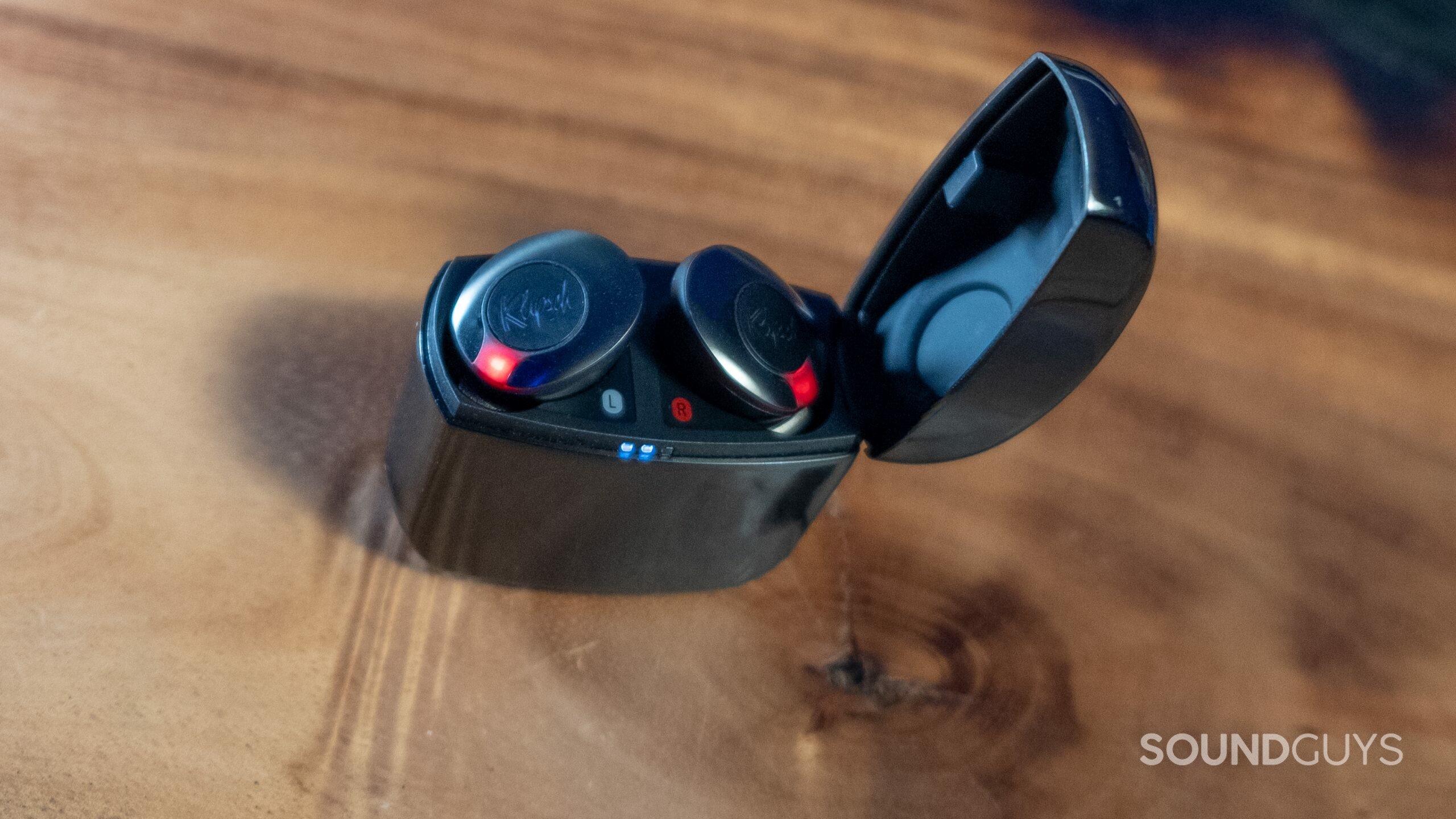
Klipsch T5 II True Wireless ANC review
August 11, 2023
Klipsch T5 II True Wireless ANC
Serious audio enthusiasts and audiophiles know of the premium audio hardware company Klipsch. Like many manufacturers entering the land of true wireless audio devices, Klipsch offers a few unique features to differentiate the T5 II ANC from the pack. A wise partnership between Klipsch and Dirac Sound improves your listening experience and puts Klipsch ahead of the game. Let’s check out what the Klipsch T5 II True Wireless ANC excels at and what could use refinement. We tested the Klipsch T5 II ANC for over three weeks to get a real sense of how it performs.
Editor’s note: this post was updated on August 11, 2023, to add the Sony WF-1000XM5 to Alternatives, and to update formatting.
Commuters will appreciate the very good isolation and active noise canceling (ANC) from these pebble-like earbuds. Audio tinkerers can play with the EQ settings and optional Dirac HD Sound mode for a pleasant custom sound. Meanwhile, folks interested in brand recognition and retro aesthetics will enjoy the thoughtful design put into the buds and case.
What’s it like to use Klipsch T5 II True Wireless ANC?
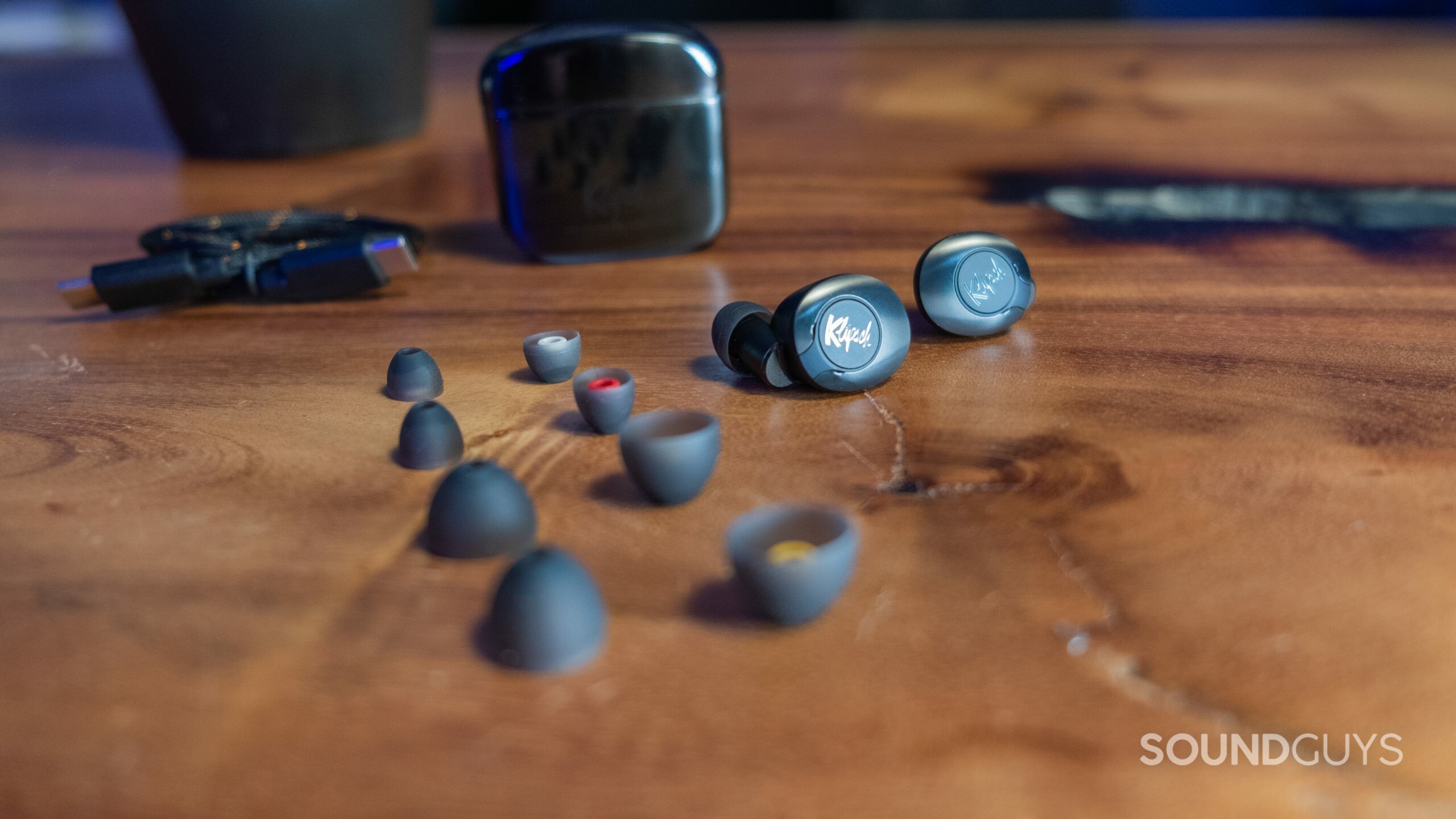
The Klipsch T5 II True Wireless ANC operates much like other true wireless earbuds and has a kind of retro-futurism design. From the hefty case to the chunky, brightly lit earbuds, this headset weds the convenience of true wireless tech with the romanticized design from bygone eras, like the Klipsch logo models. In contrast, the oversized lights on each bud shine red or blue, reminding me of the 1980s movie Tron and the synthesizers of that era. I like it, however, the design language comes off sort of confused.
Klipsch provides six differently sized oval-shaped ear tips, so almost anyone should find a size that fits. The medium fits me best and even then, it never feels secure enough and the left earbud is prone to falling from my ear. No matter how much I experiment with testing different ear tips, I surrender to a third-party pair. Even after all this trial and error, issues still crop up, and due to the buds’ chunkier size, things feel weighty after 90 minutes. Since so much of the weight sits outside the ear, this likely contributes to the T5 II ANC’s precarious fit. People with small ears may want to skip it.
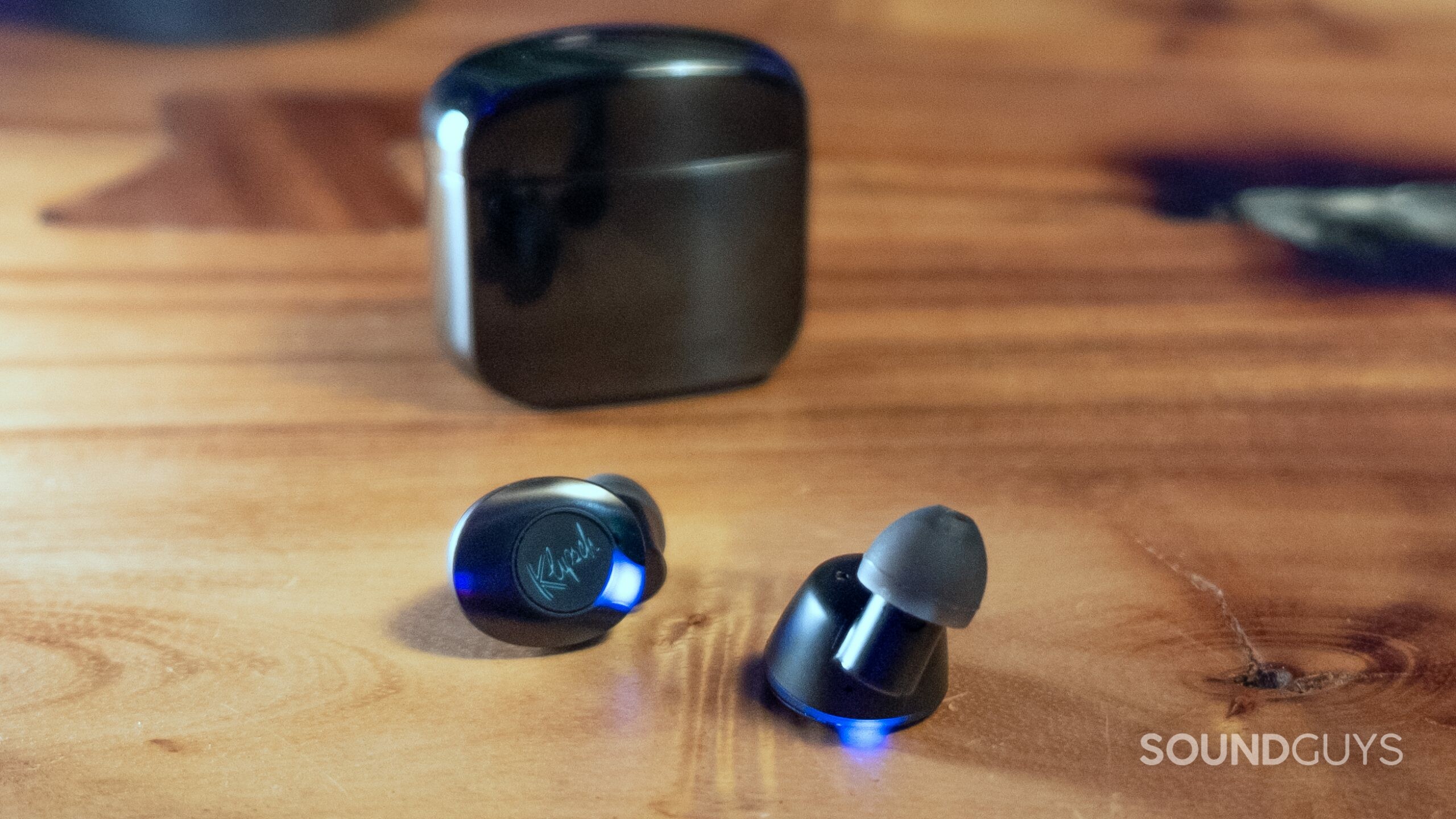
The IPX4 rating assures you that a bit of sweat will not harm the T5 II True Wireless ANC, but the fit issues aren’t confidence-inspiring. Earbuds are too expensive to risk losing or dropping, and you have far better options for working out anyway.
Your new favorite case
If one could buy battery cases separately that worked with other earbuds, I’d want the T5 II ANC battery case. The gunmetal case borrows design elements from the iconic Zippo lighter, with a smooth poly-like coating that resists dings. Thoughtful details include a rubber mat on the bottom prevents the case from scratching and sliding across various surfaces. Unlike other metal cases (e.g., Master & Dynamic MW08), this one continues to look good after continuous use. As evidence, the photos in this article are after three weeks of use — not day one.
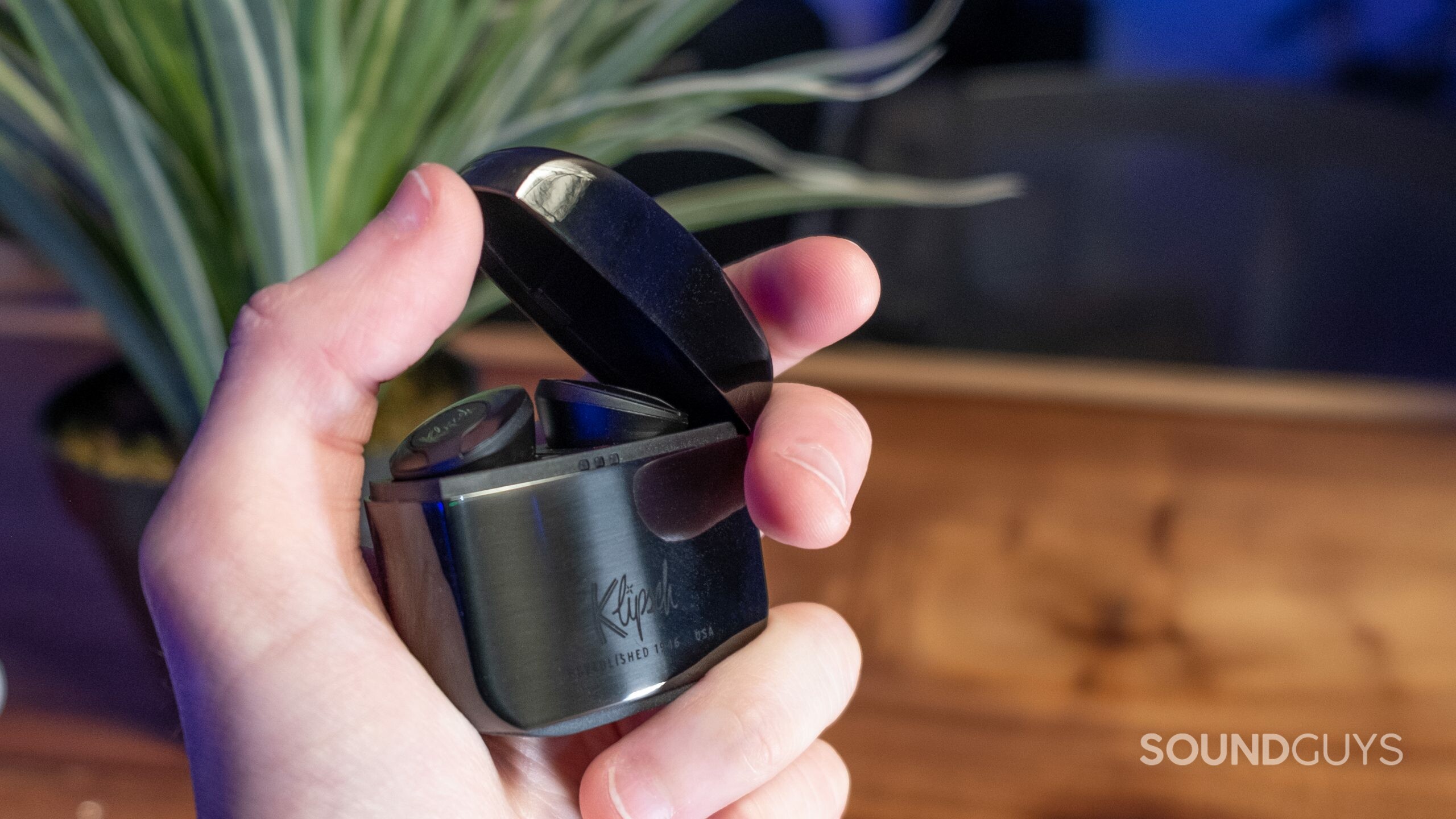
The lid flips easily with a flick of the thumb. It snaps shut again with a satisfying magnetic snap. Three square white LED indicate the battery life, and a USB-C input rests on the back. It also supports wireless charging for those who own charging mats.
The case feels a bit heavy, but at least you won’t lose track of it. A mixture of rounded, slightly squared-off corners prevents it from catching on the inside of a pocket. When empty, the case continues to stand even with the lid open, so you can replace the buds with one hand.
How do you control Klipsch T5 II True Wireless ANC?
Below is the default command configuration on the buds. You can customize the left earbud, but not the right. Buttons on the T5 II ANC buds are easy to find and a tactile click assures you that the headset registered your command. The pleasant, non-robotic voice relays things like, “noise canceling on,” which is helpful because you have to cycle through ANC, standard mode, and transparency mode if you don’t download the app. You don’t hear this voice when you trigger basic music playback controls.
| Left Earbud | Right Earbud | |
|---|---|---|
1 Press | Left Earbud ANC/Transparency mode/No mode | Right Earbud Play/Pause |
2 Presses | Left Earbud Volume up | Right Earbud Skip forward |
3 Presses | Left Earbud Volume down | Right Earbud Skip Previous |
Press and hold | Left Earbud N/A | Right Earbud Voice assistant |
More on this in the app section, but Klipsch also has a suite of command customizations that all work well except for the head gesture commands, think nods and head shakes similar to the Mobvoi Earbuds Gesture. At the moment, its functionality is limited and unreliable.
Yes, you can listen on just one earbud. Solo mode, which is for mono listening, overrides the assigned left bud buttons and uses the default right earbud controls.
Should you download the Klipsch Connect app?
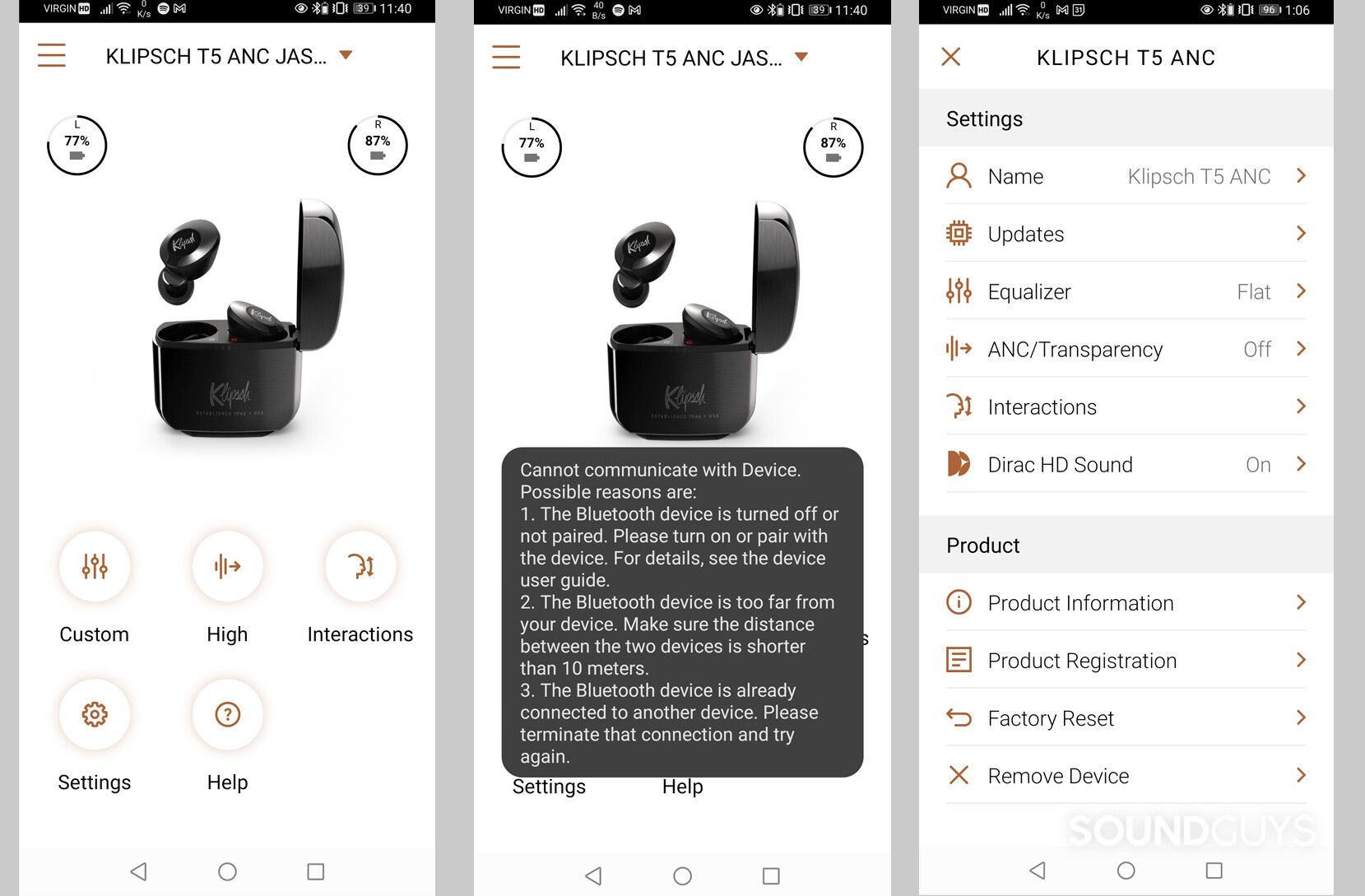
To access most of the T5 II ANC features, you’ll want to download Klipsch Connect. Even the most technophobic will want it just for firmware updates. In fact, on some devices, Klipsch all but forces you to download the app. On a HUAWEI P30, it works without the app, but with a Samsung Galaxy Z Flip 3 5G, the buds won’t finish pairing until you configure the app too. Customization runs pretty deep in the app: you can tick off settings like “activate ANC” when you listen to music or during phone calls.
Tinkerers will like that there’s a six-band equalizer to play around with, and visual learners will better understand how the changes affect the frequency response. You only get one custom setting, and six presets. Unfortunately, if you try to adjust a preset it overrides your previous custom setting.
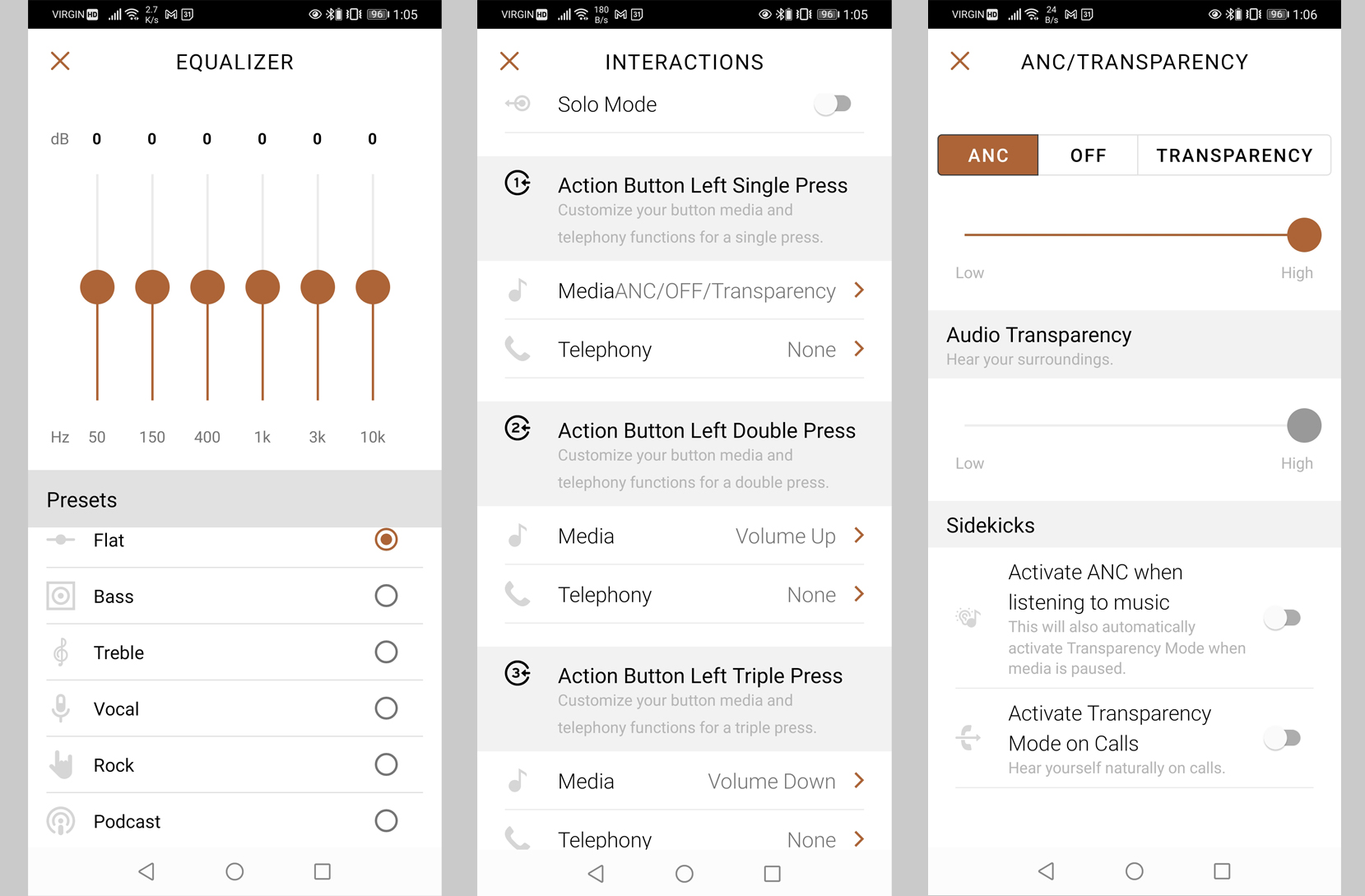
Also worth testing out is Dirac HD Sound, a sort of mini version of the Swedish DSP processor included in the Klipsch Connect app.
You can activate gestures from the app’s Interactions page. At the time of this review, the gestures are minimal: nod three times to answer a call, shake three times to reject a call. The skip track function (three head shakes) is still in beta, and does not work reliably.
How does the Klipsch T5 II True Wireless ANC connect?
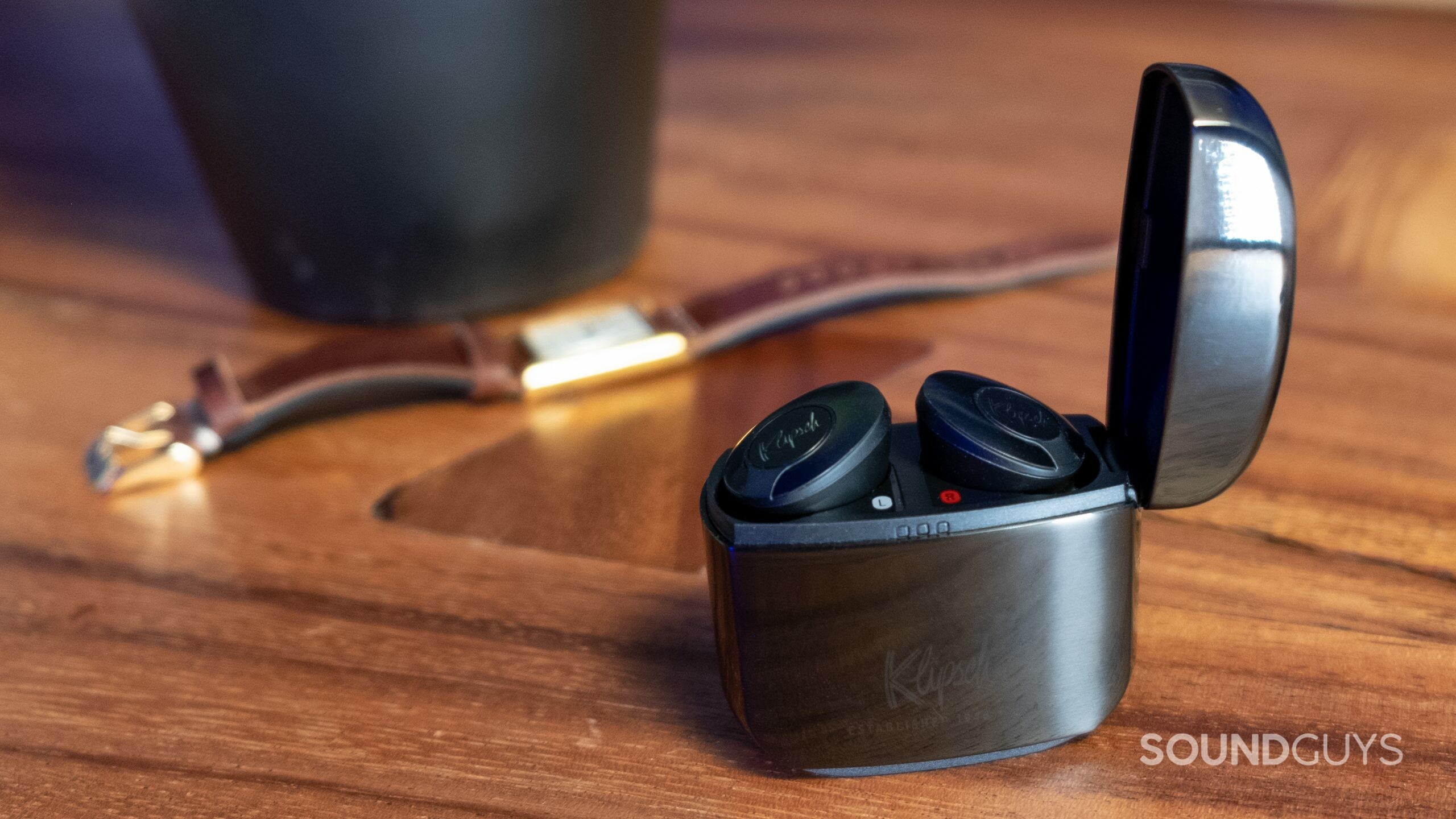
The Bluetooth 5.0 connection remains stable on Android and iOS. You get your choice between the AAC and SBC Bluetooth codecs, no aptX here. Interestingly, the non-ANC T5 II version supports the higher quality aptX codec. This is an odd omission considering that folks who choose to get ANC often also care about sound quality.
Pairing happens quickly. Blue lights flash on the buds and a voice will tell you that you’ve paired, dispelling any ambiguity. Sometimes the app will say it can’t connect to the earbuds, but then it does anyway. This varies from device to device, and when streaming YouTube over AAC on Android yields some slight latency. iPhone users will probably experience less latency because AAC cooperates with iPhone better than with Android.
The buds ought to automatically enter pairing mode when you remove them from the case (provided they’re charged). A voice will say, “ready to pair,” to announce the mode. If that does not happen, put the buds back and try again. This time press and hold the button on the right earbud for three seconds. Doing so manually forces pairing mode. From there you finish the pairing process like you would any other Bluetooth earbuds.
How long does the battery last on the Klipsch T5 II ANC?
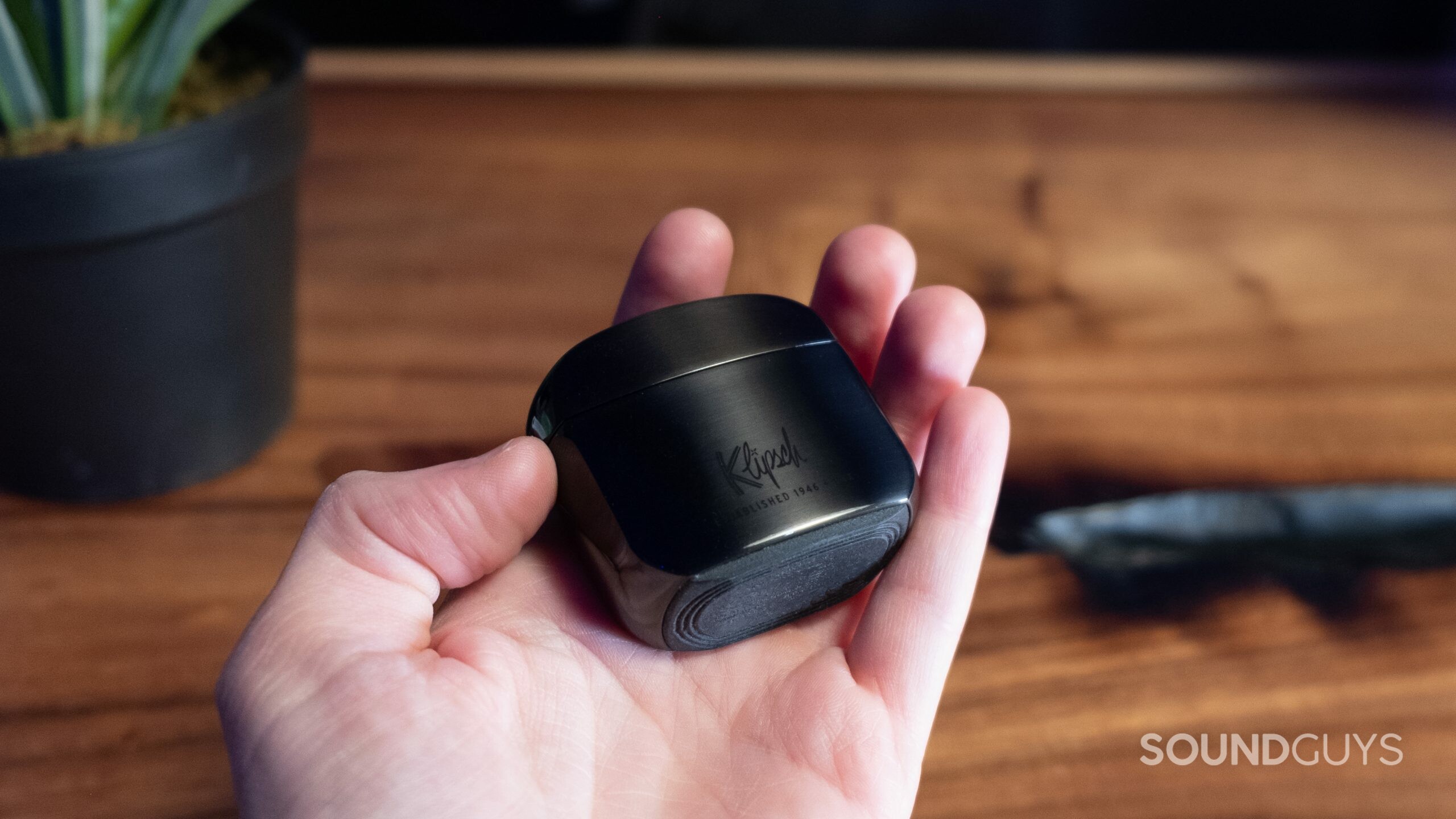
Under our standard battery test, a constant output of music peaking at 75dB(SPL) until battery depletion, the Klipsch T5 II ANC lasts 3 hours, 20 minutes with ANC on. This is notably less playtime than competing ANC wireless earbuds supply, but the case supplies an additional 15 to 21 hours of battery life, depending on whether you’ve activated ANC. That battery life is a real mark against the T5 II ANC at this price.
Does the Klipsch T5 II True Wireless ANC have good noise canceling?
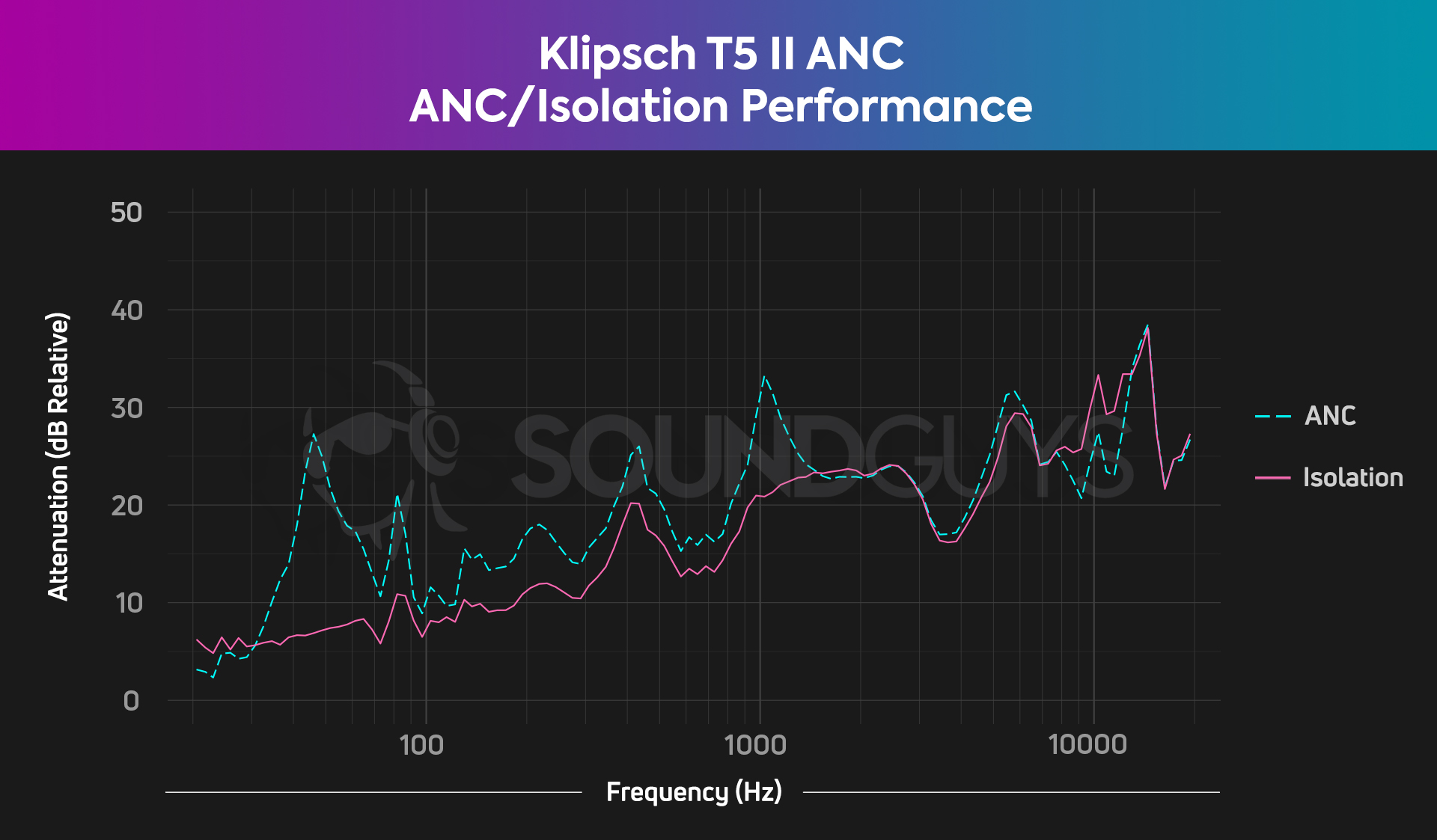
competing ANC wireless earbuds and isolation performance sit well above average with the T5 II ANC. For the most part, I find isolation does its job so well that I scarcely need to turn on the noise canceling, even on the bus. When set to high, ANC reduces low frequency noise handily and then decently through the mids and up to 1kHz. The ANC seems most useful below 100Hz, if uneven in application.
Klipsch provides a slider in the Klipsch Connect app, allowing users to adjust the noise canceling intensity. The slider also adjusts transparency mode for when you want to remain aware of street sounds. Good isolation and ANC mean you can keep your volume at a reasonable level to save your hearing, and the T5 II ANC does it well.
How does the Klipsch T5 II True Wireless ANC sound?
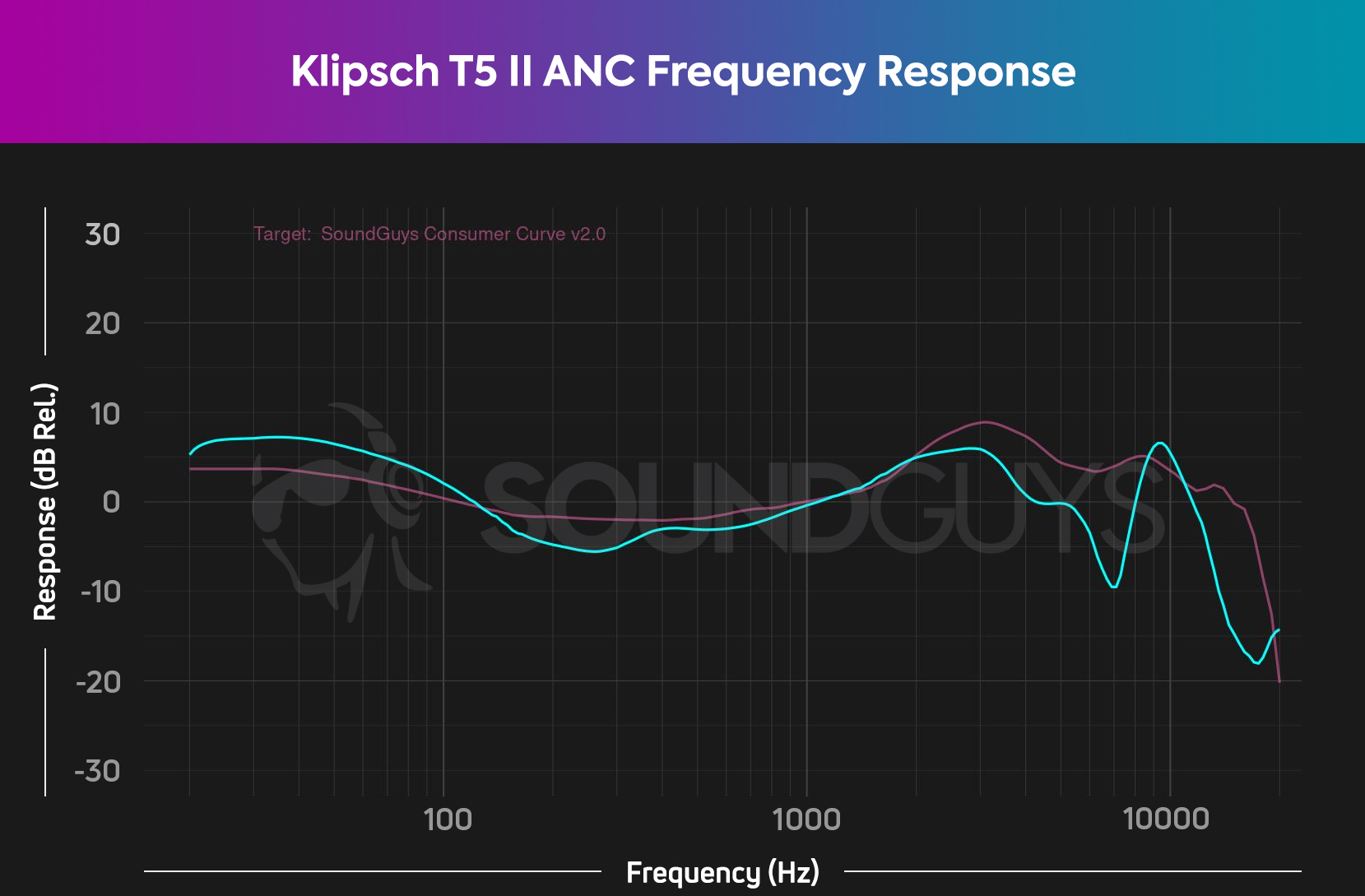
The Klipsch T5 II ANC’s frequency response boosts bass notes a bit more than what our preferred curve posits as the platonic ideal but remains consumer-friendly.
There’s a 10-12dB difference between the loudest sub-bass and quietest midrange notes, making it hard to hear vocals and string instruments. Treble notes will sound relatively quiet, with the treble response under-emphasized around 3kHz before it’s boosted back around 10kHz only to drop off again. The above chart shows the default frequency response when you first listen to the Klipsch T5 II ANC, which is the Flat EQ setting and Dirac HD Sound on.
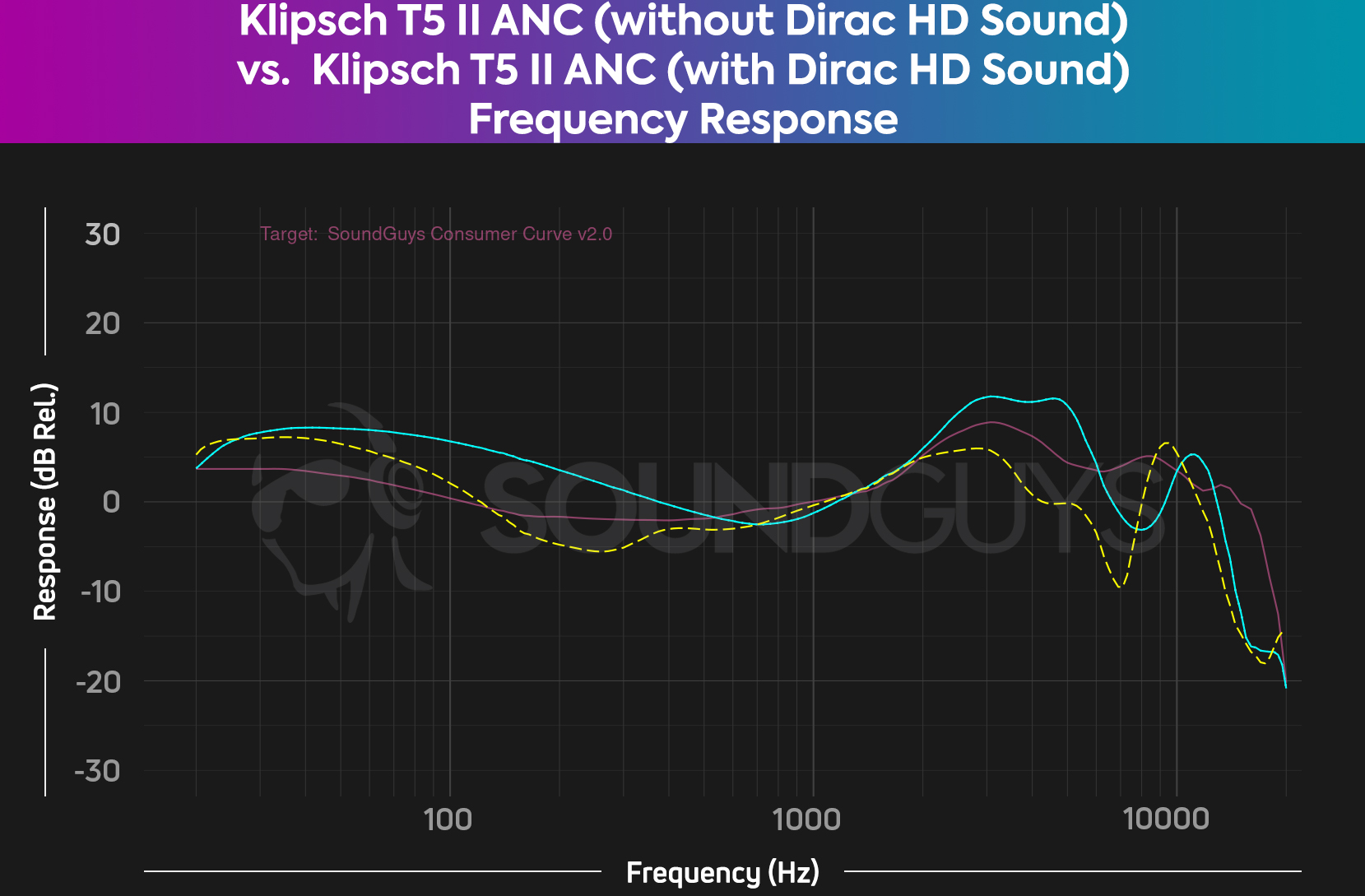
The general gist of the Klipsch T5 II ANC without Dirac HD Sound looks like a pretty standard “hyped” sound for consumer earphones, though bass sub-bass and bass notes are markedly boosted without Dirac HD Sound enabled. It may be a good idea to turn off Dirac HD Sound if you plan to work out, as most people like quite a bit more bass when exercising.
Dirac HD Sound essentially finesses and refines the frequency response to make it more versatile across genres. Dirac minimizes the exaggerated bass and treble notes, and most listeners will want to leave it on. Midrange notes sound pretty similar on either mode, so it’s a matter of your bass and treble preferences.
Lows, mids, and highs
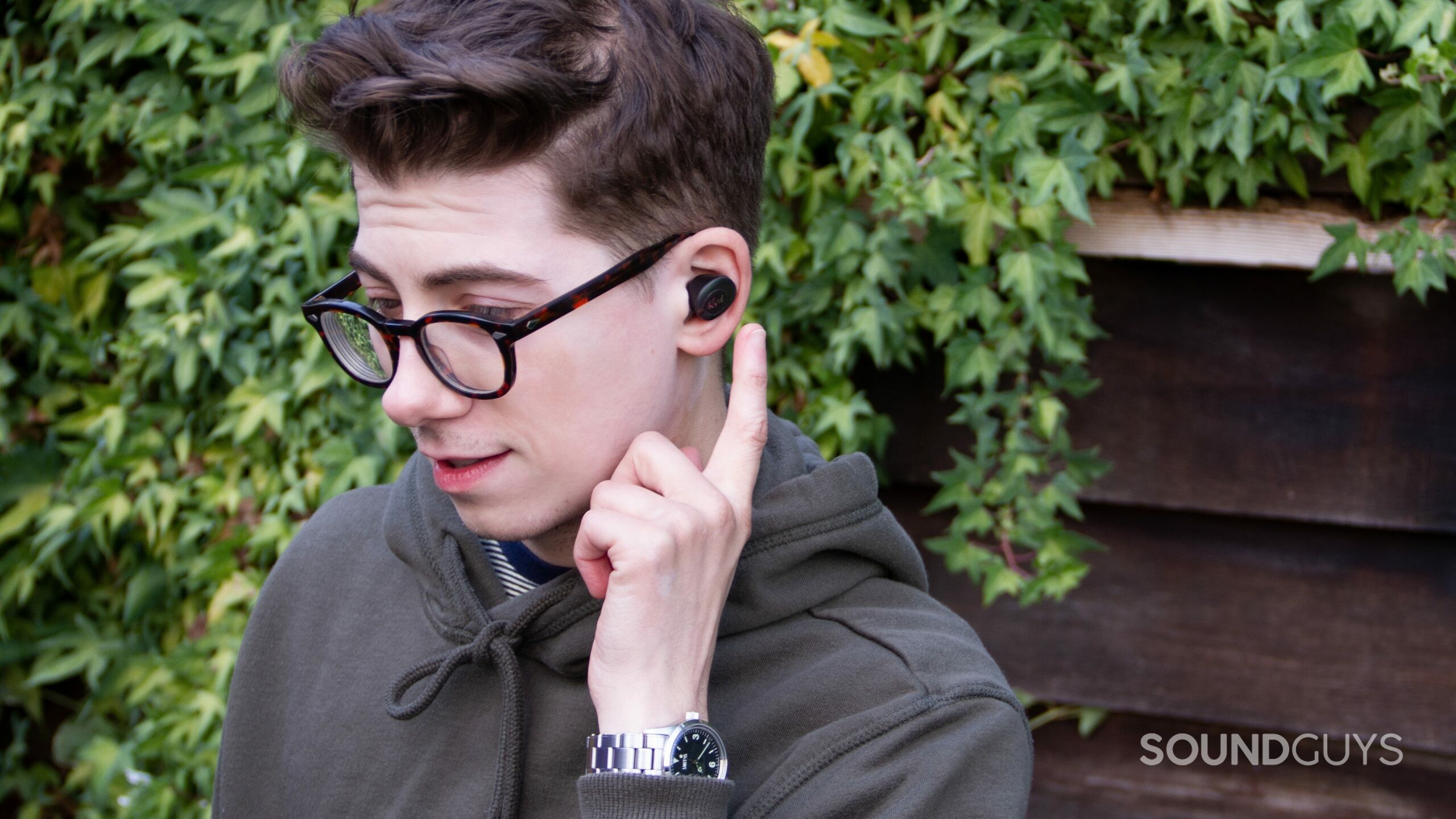
With the default settings, Girl by Girl Ray has a good amount of bassy oomph on the kick drum. When the bass section starts up, it propels the tempo. While this might be a touch too much bass, the Beats market has taught us that a lot of Best bass earbuds, and this emphasis seems in the ballpark of reasonable. Clean electric rhythm guitar comes through, though it gets a bit masked by the (arguably, mixed slightly too loud) high midrange synth lead.
Poppy Hankin’s vocals are unfortunately lost due to the relatively quiet highs. This is most obvious in the outro around 3:10 when all the instruments play in a kind of crescendo. The frequency response bump at 10kHz does lend perceived clarity to her vocals, yet even in the sparse verses, I just want to turn her up a little. Again, this is why Klipsch gives you some tools to sort out the sound to your liking.
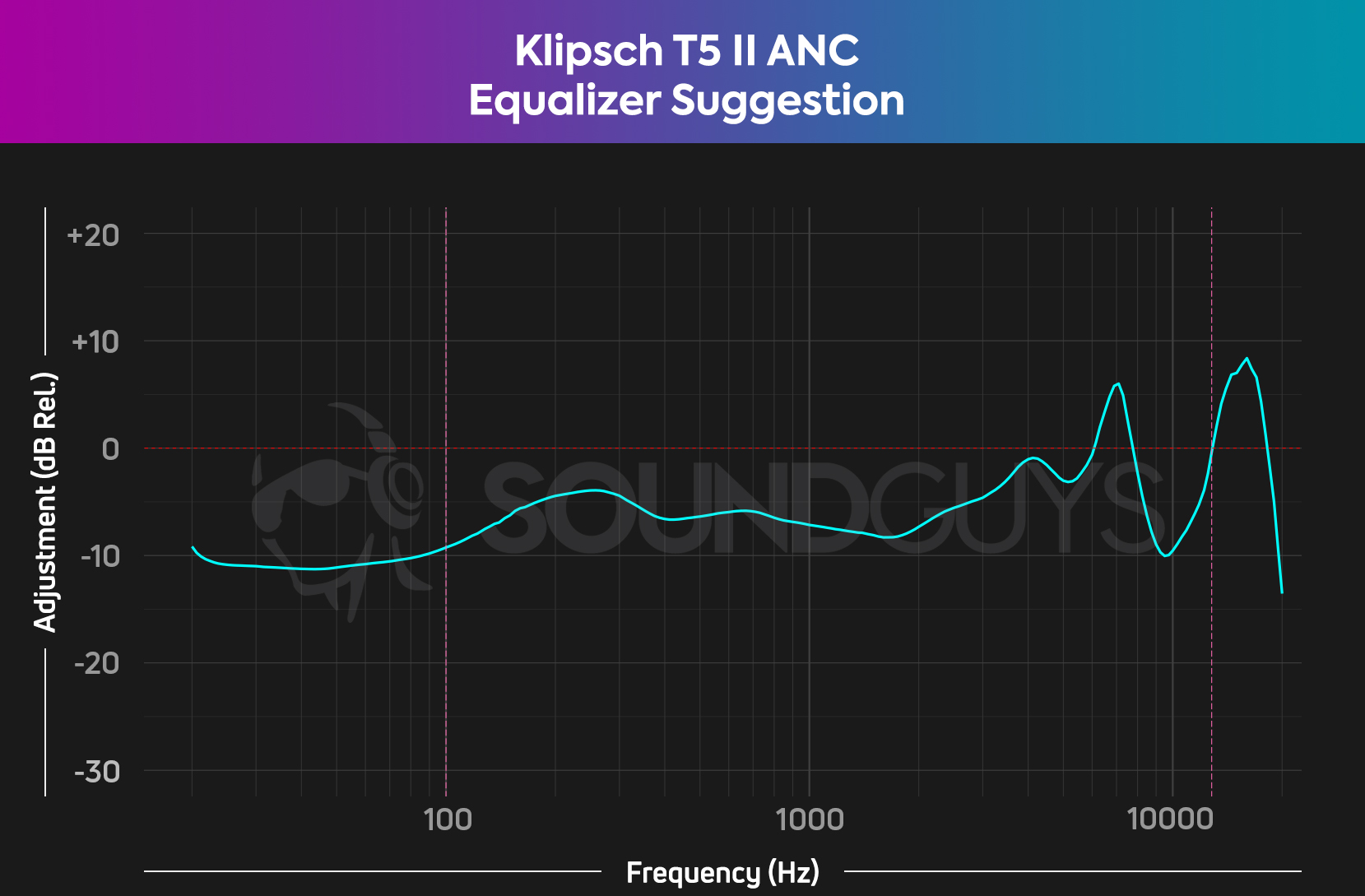
You can try improving the T5 II ANC’s sound by interacting with the minimal EQ slider. If you want a simple approach, I notice a difference just bumping the 3kHz slider up 3dB to 5dB, and dropping the 50Hz and 150Hz by 2dB or more. Unfortunately, it does not allow you to address the nearly 15dB volume drop at 7kHz, because the EQ slider ranges jump from 3kHz to 10kHz.
Can you use the Klipsch T5 II True Wireless ANC for phone calls?
Absolutely, you can use the Klipsch T5 II ANC for phone calls. High-pitched voices may sound a bit quieter than normal; on the whole, this transmits voices well and clearly enough for casual calls. Most impressive is the ability of the T5 II ANC to reject noise. In the microphone demo, you can hear how the fan noise gets picked up but as soon as a voice comes through, the mics filter out the noise and leave the voice virtually unaltered.
Klipsch T5 II True Wireless ANC microphone demo (Non-standardized):
How does the microphone sound to you?
Hold up! Something’s different:
We’ve made a big improvement to how we demonstrate the microphone performance of products we review. We now use a standardized test setup that plays back pre-recorded phrases from a calibrated artificial mouth in our test chamber, either with or without simulated background noises, simulated reverberant spaces, or artificial wind. This means that samples from every product can be directly compared, which makes it far easier to make meaningful comparisons between products in terms of the raw speech quality or the product’s ability to reject noise.
It will take a while to update our backlog of old test results, but we will update this review (and many others!) once we’re able with improved microphone demos. These will be made obvious in each new sample which begins with the phrase, “This is a SoundGuys standardized microphone demonstration …”
Thank you for bearing with us, and we hope to see you again once we’ve sorted everything out.
Should you buy Klipsch T5 II True Wireless ANC?
Well, if you can get a good fit the Klipsch T5 II True Wireless ANC experience is pretty likable, albeit, quirky. The buttons work predictably, but head gestures are a mixed bag. Bluetooth pairs easily and stays connected. Meanwhile, ANC and isolation perform very well, and the charging case ought to win some kind of award.
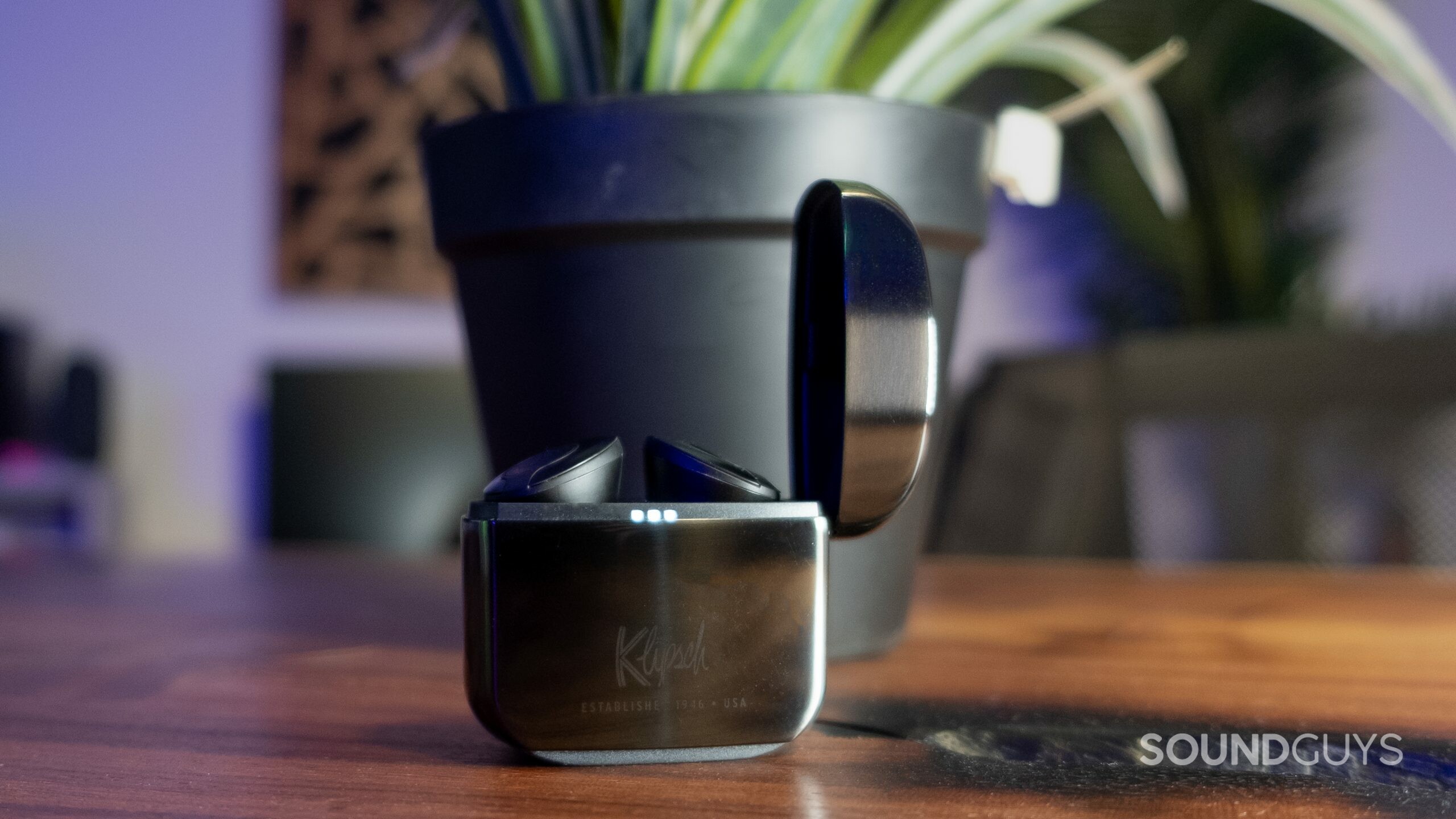
You get the sense that the T5 II ANC is the product of three different design teams: one excelled with the case, one did an alright job with the app — save for the off-beat organization and the weird Bluetooth connection pop-up, and another team did okay with the buds. The quality of the case just doesn’t jive with the sort of bulky fit of the buds. Adorning both with the same vintage logo doesn’t marry the awkward couple either.
Like a cheerleader, you want the T5 II ANC to secure a win, but unfortunately, it stands as evidence that a proper fit trumps pretty much everything else. The T5 II ANC might not work for you unless you have historically easy-to-fit ears. Anyone who has smaller ears should purchase this from a retailer with a forgiving return policy, just in case. Battery life is low for true wireless earbuds these days too. For the person who the T5 II ANC fits, it’s a fun set of buds, but too expensive.

What should you get instead of the Klipsch T5 II ANC?
The Klipsch T5 II True Wireless ANC is not cheap and likely doesn’t bode well for most peoples’ budgets. If you like everything else about the T5 II ANC but don’t need noise cancelation, try the non-ANC Klipsch T5 II on the product’s website. You can sometimes find it for about half the price. It comes with a better aptX codec, and while we haven’t had a chance to test it, the housing shape appears the same, so the isolation likely works very well. In other words, you don’t get ANC, but you still get really good isolation.
Perhaps the price of Klipsch’s earbuds doesn’t bother you, and you just want the best; in that case, spring for the Sony WF-1000XM5. The WF-1000XM5 ($298 at Amazon) offers a suite of different codecs, Sony’s own DSP, DSEE Extreme to upscale your low-quality audio files, and of course, you get Sony 360 Reality Audio. In addition, ANC performs admirably well. By virtue of everyone’s individual anatomy, comfort is a subjective measurement, and still, the WF-1000XM5 rates higher for comfort. Plus, a battery life that roughly triples the Klipsch buds makes for a far better pick. Still, if that price is too dear the Sony WF-1000XM4 remains an excellent choice for $278 at Amazon, even if the buds are chunkier than the XM5.
For a slightly different look with very good ANC, turn to the Sennheiser MOMENTUM True Wireless 3 ($169 at Amazon). This set of noise canceling earbuds is a bit sportier than Klipsch’s or Sony’s due to the inclusion of removable ear wings. These wings are great for stabilizing the IPX4-rated buds. You can get a highly customized ANC and EQ experience through “Sound Zones,” a feature in the free Smart Control app. This detects where you are on a map and automatically enables your preferred ANC settings for that location (and when you exit it).
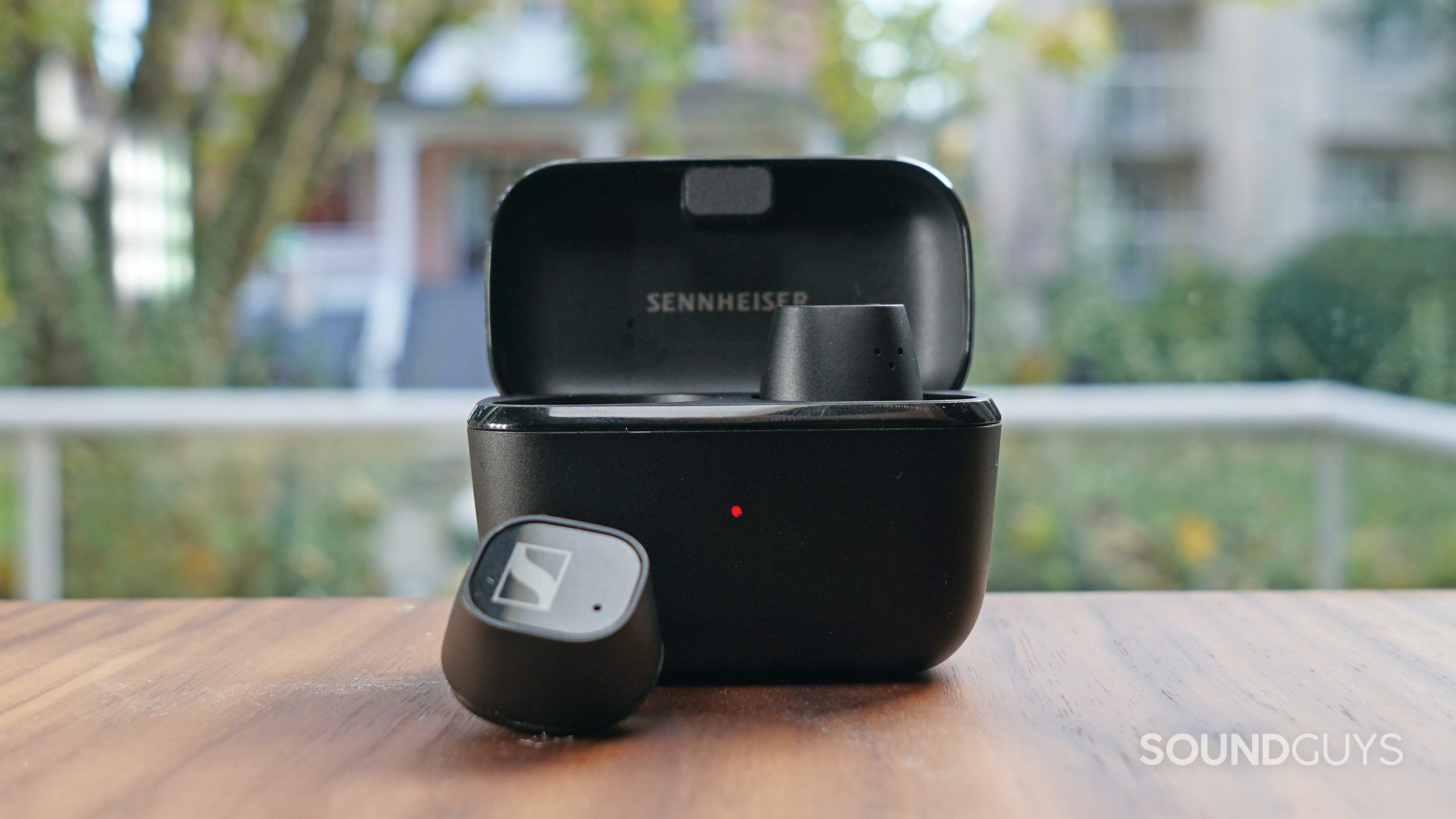
Finally, for the person looking to get some excellent ANC and aptX codec, look into the Sennheiser CX Plus True Wireless. It sells for $89 at Amazon which is quite a bit less than the Sony WF-1000XM5 and Klipsch T5 II ANC as well, for example, but it performs very nicely. Most people will like the sound, and the accompanying app has an equalizer if needed. It might not be “the best,” but it’s more than capable for most of us.
Frequently asked questions about Klipsch T5 II ANC
The Bose QuietComfort Earbuds II has some things going for it, including a refined design and fit, but it also costs quite a bit of money for what’s there. It sounds too bass heavy for one. You also can’t even turn off the ANC, for the times you are already sitting in silence.
Technically, yes, you can work out with the T5 II ANC, due to its sweat-resistant IPX4 rating. Unfortunately, its large size, finicky fit, and lack of stabilizers or wings make it less than ideal for a lot of athletes.
While it’s true that active noise canceling (ANC) comes at a premium, it can also save your hearing, which is almost priceless. It does this by reducing surrounding environmental sounds, which means your audio does not compete with external noise. Having less external noise means you are less compelled to crank the volume in an attempt to overwhelm the noise.
Finally, some folks have found that ANC can also help with productivity, as it reduces distracting sounds, so you can focus on what you’re doing.
Thank you for being part of our community. Read our Comment Policy before posting.